Meeting the Needs of Individuals Through Multidisciplinary Care Report
VerifiedAdded on 2020/10/22
|11
|3503
|60
Report
AI Summary
This report delves into the principles of multidisciplinary care, focusing on its application within the context of Ebury Court Care Home. It examines the crucial role of healthcare practitioners in supporting patient-centered care, emphasizing the importance of effective communication and active listening to determine individual needs. The report further explores leadership styles that promote effective teamwork and interpersonal relationships within multidisciplinary teams, highlighting the responsibilities of information sharing. Different communication methods and strategies are discussed to meet the diverse care needs of service users, with an emphasis on adapting approaches to suit individual preferences and requirements. The report underscores the significance of integrating care processes, promoting patient involvement in treatment decisions, and fostering an environment of respect and dignity to achieve optimal patient outcomes. The report also discusses the importance of the integrated care and autonomous leadership to address the complex needs of patients and the importance of team work to facilitate professional development and improve decision making skills. The report concludes by emphasizing the need for effective communication and a patient-centered approach to improve the overall well being of patients.
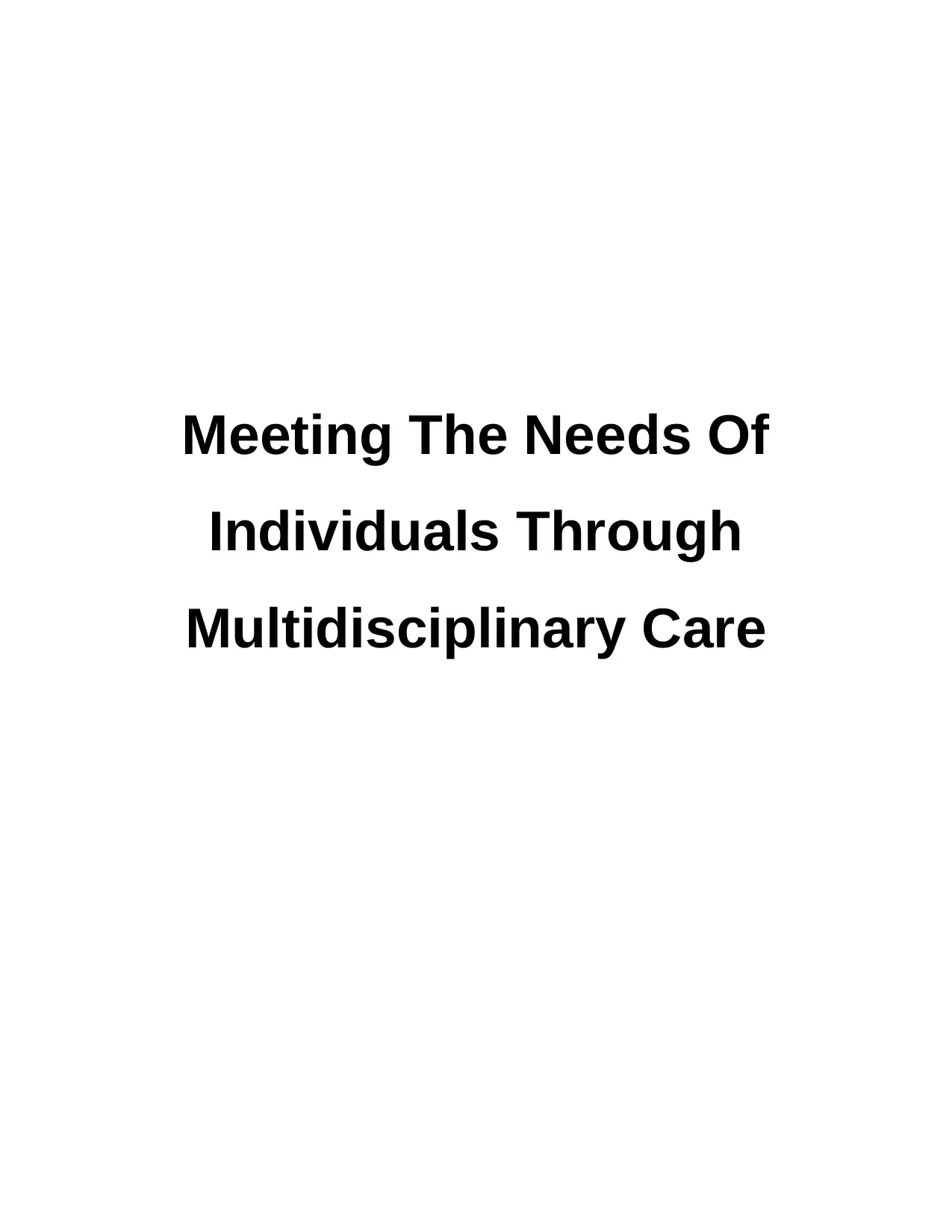
Meeting The Needs Of
Individuals Through
Multidisciplinary Care
Individuals Through
Multidisciplinary Care
Paraphrase This Document
Need a fresh take? Get an instant paraphrase of this document with our AI Paraphraser
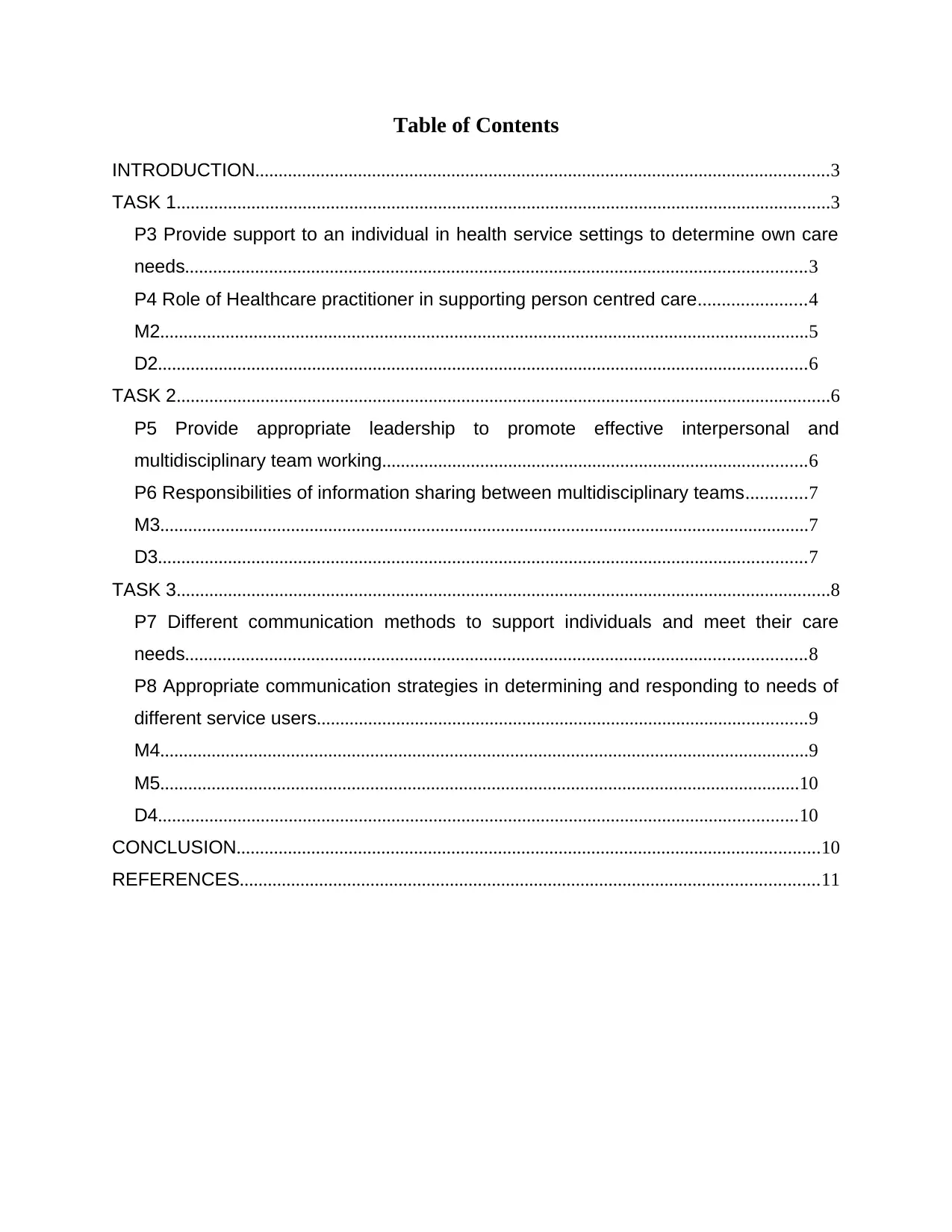
Table of Contents
INTRODUCTION...........................................................................................................................3
TASK 1............................................................................................................................................3
P3 Provide support to an individual in health service settings to determine own care
needs.....................................................................................................................................3
P4 Role of Healthcare practitioner in supporting person centred care.......................4
M2...........................................................................................................................................5
D2...........................................................................................................................................6
TASK 2............................................................................................................................................6
P5 Provide appropriate leadership to promote effective interpersonal and
multidisciplinary team working...........................................................................................6
P6 Responsibilities of information sharing between multidisciplinary teams.............7
M3...........................................................................................................................................7
D3...........................................................................................................................................7
TASK 3............................................................................................................................................8
P7 Different communication methods to support individuals and meet their care
needs.....................................................................................................................................8
P8 Appropriate communication strategies in determining and responding to needs of
different service users.........................................................................................................9
M4...........................................................................................................................................9
M5.........................................................................................................................................10
D4.........................................................................................................................................10
CONCLUSION.............................................................................................................................10
REFERENCES............................................................................................................................11
INTRODUCTION...........................................................................................................................3
TASK 1............................................................................................................................................3
P3 Provide support to an individual in health service settings to determine own care
needs.....................................................................................................................................3
P4 Role of Healthcare practitioner in supporting person centred care.......................4
M2...........................................................................................................................................5
D2...........................................................................................................................................6
TASK 2............................................................................................................................................6
P5 Provide appropriate leadership to promote effective interpersonal and
multidisciplinary team working...........................................................................................6
P6 Responsibilities of information sharing between multidisciplinary teams.............7
M3...........................................................................................................................................7
D3...........................................................................................................................................7
TASK 3............................................................................................................................................8
P7 Different communication methods to support individuals and meet their care
needs.....................................................................................................................................8
P8 Appropriate communication strategies in determining and responding to needs of
different service users.........................................................................................................9
M4...........................................................................................................................................9
M5.........................................................................................................................................10
D4.........................................................................................................................................10
CONCLUSION.............................................................................................................................10
REFERENCES............................................................................................................................11
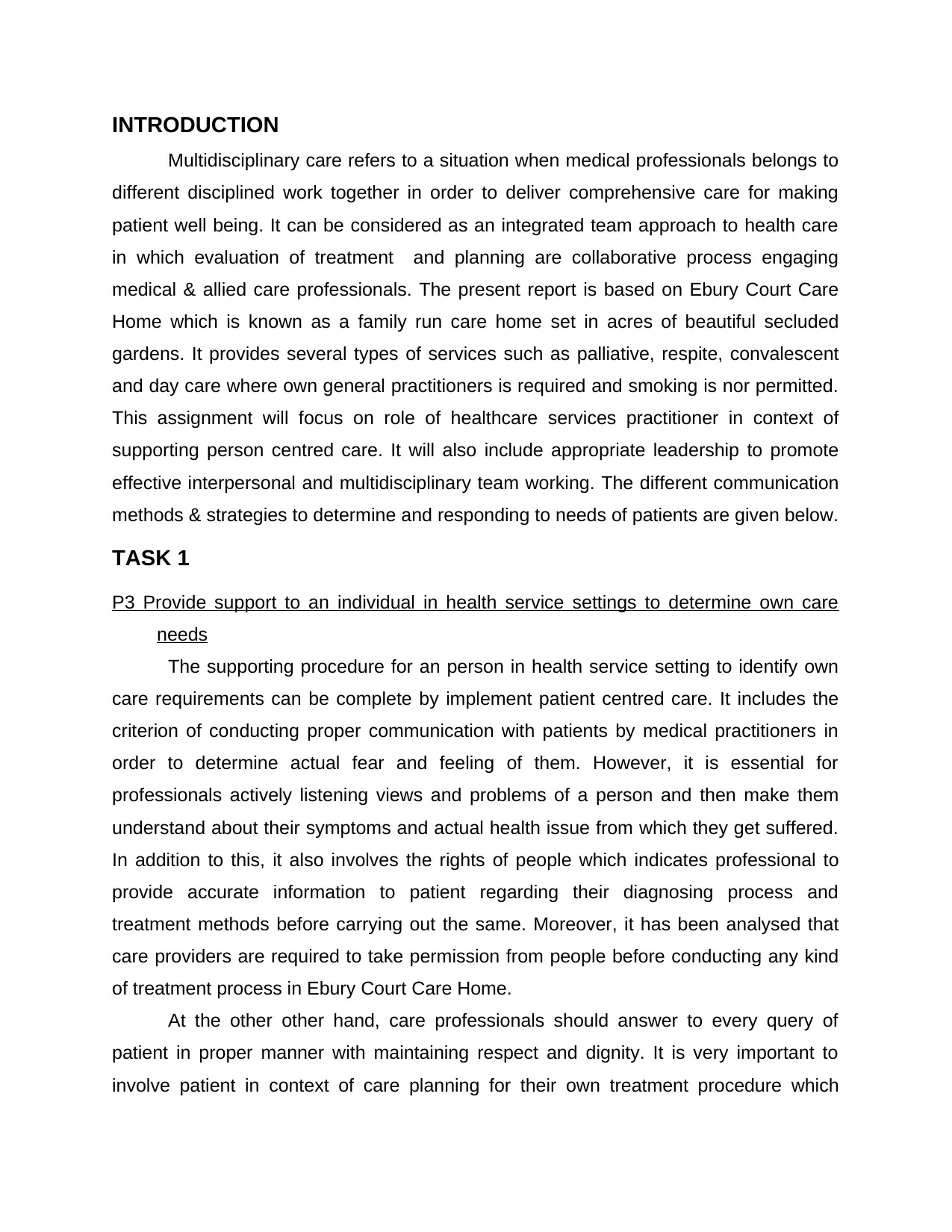
INTRODUCTION
Multidisciplinary care refers to a situation when medical professionals belongs to
different disciplined work together in order to deliver comprehensive care for making
patient well being. It can be considered as an integrated team approach to health care
in which evaluation of treatment and planning are collaborative process engaging
medical & allied care professionals. The present report is based on Ebury Court Care
Home which is known as a family run care home set in acres of beautiful secluded
gardens. It provides several types of services such as palliative, respite, convalescent
and day care where own general practitioners is required and smoking is nor permitted.
This assignment will focus on role of healthcare services practitioner in context of
supporting person centred care. It will also include appropriate leadership to promote
effective interpersonal and multidisciplinary team working. The different communication
methods & strategies to determine and responding to needs of patients are given below.
TASK 1
P3 Provide support to an individual in health service settings to determine own care
needs
The supporting procedure for an person in health service setting to identify own
care requirements can be complete by implement patient centred care. It includes the
criterion of conducting proper communication with patients by medical practitioners in
order to determine actual fear and feeling of them. However, it is essential for
professionals actively listening views and problems of a person and then make them
understand about their symptoms and actual health issue from which they get suffered.
In addition to this, it also involves the rights of people which indicates professional to
provide accurate information to patient regarding their diagnosing process and
treatment methods before carrying out the same. Moreover, it has been analysed that
care providers are required to take permission from people before conducting any kind
of treatment process in Ebury Court Care Home.
At the other other hand, care professionals should answer to every query of
patient in proper manner with maintaining respect and dignity. It is very important to
involve patient in context of care planning for their own treatment procedure which
Multidisciplinary care refers to a situation when medical professionals belongs to
different disciplined work together in order to deliver comprehensive care for making
patient well being. It can be considered as an integrated team approach to health care
in which evaluation of treatment and planning are collaborative process engaging
medical & allied care professionals. The present report is based on Ebury Court Care
Home which is known as a family run care home set in acres of beautiful secluded
gardens. It provides several types of services such as palliative, respite, convalescent
and day care where own general practitioners is required and smoking is nor permitted.
This assignment will focus on role of healthcare services practitioner in context of
supporting person centred care. It will also include appropriate leadership to promote
effective interpersonal and multidisciplinary team working. The different communication
methods & strategies to determine and responding to needs of patients are given below.
TASK 1
P3 Provide support to an individual in health service settings to determine own care
needs
The supporting procedure for an person in health service setting to identify own
care requirements can be complete by implement patient centred care. It includes the
criterion of conducting proper communication with patients by medical practitioners in
order to determine actual fear and feeling of them. However, it is essential for
professionals actively listening views and problems of a person and then make them
understand about their symptoms and actual health issue from which they get suffered.
In addition to this, it also involves the rights of people which indicates professional to
provide accurate information to patient regarding their diagnosing process and
treatment methods before carrying out the same. Moreover, it has been analysed that
care providers are required to take permission from people before conducting any kind
of treatment process in Ebury Court Care Home.
At the other other hand, care professionals should answer to every query of
patient in proper manner with maintaining respect and dignity. It is very important to
involve patient in context of care planning for their own treatment procedure which
⊘ This is a preview!⊘
Do you want full access?
Subscribe today to unlock all pages.

Trusted by 1+ million students worldwide
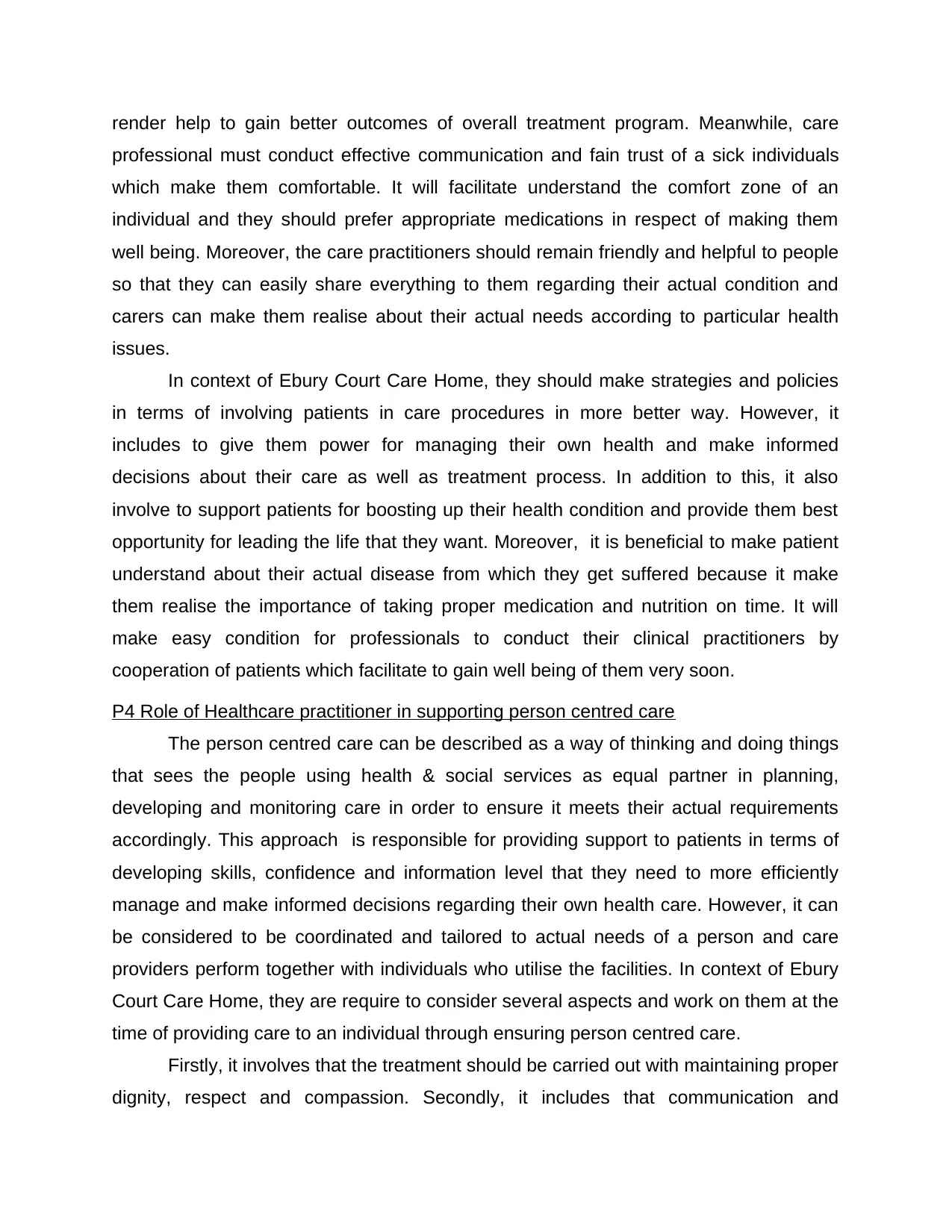
render help to gain better outcomes of overall treatment program. Meanwhile, care
professional must conduct effective communication and fain trust of a sick individuals
which make them comfortable. It will facilitate understand the comfort zone of an
individual and they should prefer appropriate medications in respect of making them
well being. Moreover, the care practitioners should remain friendly and helpful to people
so that they can easily share everything to them regarding their actual condition and
carers can make them realise about their actual needs according to particular health
issues.
In context of Ebury Court Care Home, they should make strategies and policies
in terms of involving patients in care procedures in more better way. However, it
includes to give them power for managing their own health and make informed
decisions about their care as well as treatment process. In addition to this, it also
involve to support patients for boosting up their health condition and provide them best
opportunity for leading the life that they want. Moreover, it is beneficial to make patient
understand about their actual disease from which they get suffered because it make
them realise the importance of taking proper medication and nutrition on time. It will
make easy condition for professionals to conduct their clinical practitioners by
cooperation of patients which facilitate to gain well being of them very soon.
P4 Role of Healthcare practitioner in supporting person centred care
The person centred care can be described as a way of thinking and doing things
that sees the people using health & social services as equal partner in planning,
developing and monitoring care in order to ensure it meets their actual requirements
accordingly. This approach is responsible for providing support to patients in terms of
developing skills, confidence and information level that they need to more efficiently
manage and make informed decisions regarding their own health care. However, it can
be considered to be coordinated and tailored to actual needs of a person and care
providers perform together with individuals who utilise the facilities. In context of Ebury
Court Care Home, they are require to consider several aspects and work on them at the
time of providing care to an individual through ensuring person centred care.
Firstly, it involves that the treatment should be carried out with maintaining proper
dignity, respect and compassion. Secondly, it includes that communication and
professional must conduct effective communication and fain trust of a sick individuals
which make them comfortable. It will facilitate understand the comfort zone of an
individual and they should prefer appropriate medications in respect of making them
well being. Moreover, the care practitioners should remain friendly and helpful to people
so that they can easily share everything to them regarding their actual condition and
carers can make them realise about their actual needs according to particular health
issues.
In context of Ebury Court Care Home, they should make strategies and policies
in terms of involving patients in care procedures in more better way. However, it
includes to give them power for managing their own health and make informed
decisions about their care as well as treatment process. In addition to this, it also
involve to support patients for boosting up their health condition and provide them best
opportunity for leading the life that they want. Moreover, it is beneficial to make patient
understand about their actual disease from which they get suffered because it make
them realise the importance of taking proper medication and nutrition on time. It will
make easy condition for professionals to conduct their clinical practitioners by
cooperation of patients which facilitate to gain well being of them very soon.
P4 Role of Healthcare practitioner in supporting person centred care
The person centred care can be described as a way of thinking and doing things
that sees the people using health & social services as equal partner in planning,
developing and monitoring care in order to ensure it meets their actual requirements
accordingly. This approach is responsible for providing support to patients in terms of
developing skills, confidence and information level that they need to more efficiently
manage and make informed decisions regarding their own health care. However, it can
be considered to be coordinated and tailored to actual needs of a person and care
providers perform together with individuals who utilise the facilities. In context of Ebury
Court Care Home, they are require to consider several aspects and work on them at the
time of providing care to an individual through ensuring person centred care.
Firstly, it involves that the treatment should be carried out with maintaining proper
dignity, respect and compassion. Secondly, it includes that communication and
Paraphrase This Document
Need a fresh take? Get an instant paraphrase of this document with our AI Paraphraser
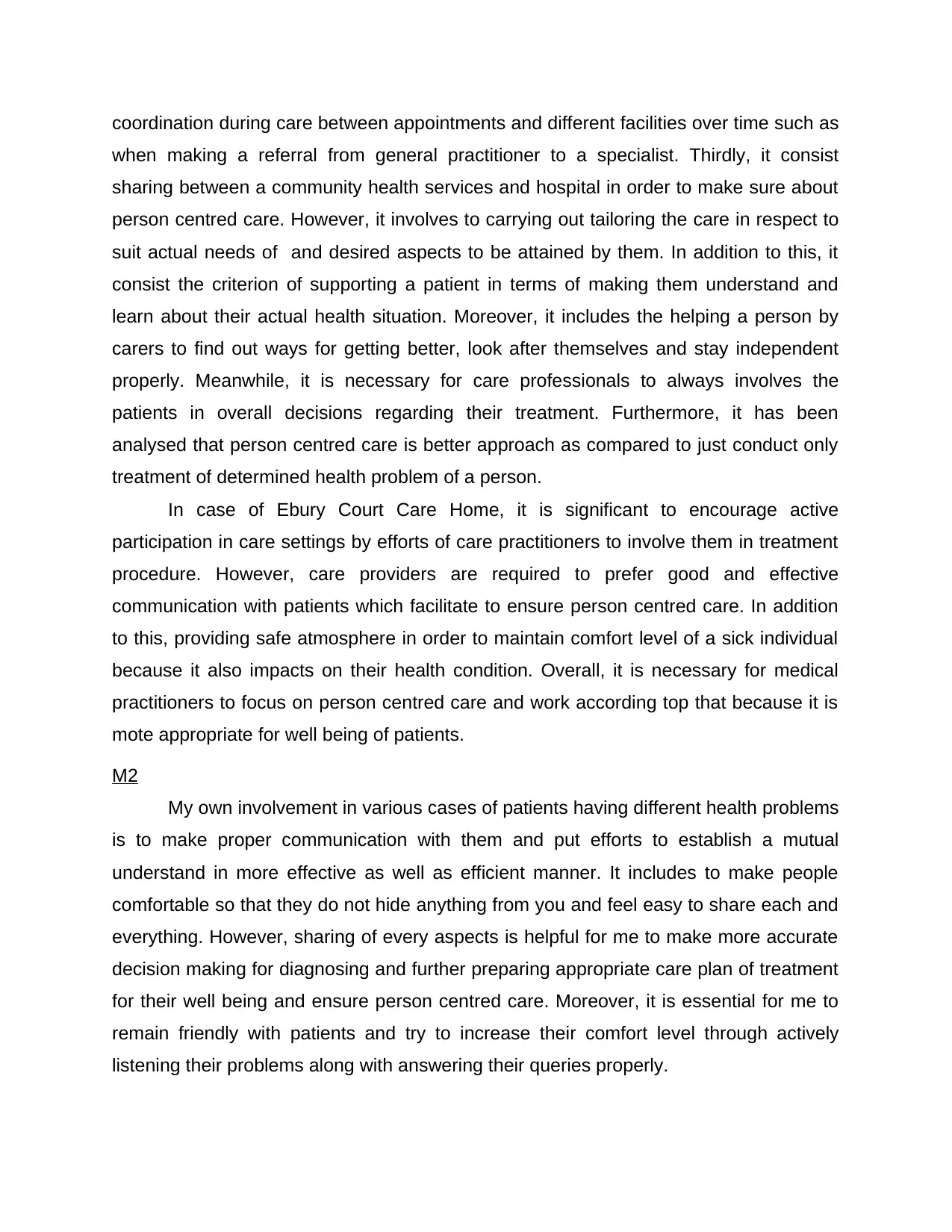
coordination during care between appointments and different facilities over time such as
when making a referral from general practitioner to a specialist. Thirdly, it consist
sharing between a community health services and hospital in order to make sure about
person centred care. However, it involves to carrying out tailoring the care in respect to
suit actual needs of and desired aspects to be attained by them. In addition to this, it
consist the criterion of supporting a patient in terms of making them understand and
learn about their actual health situation. Moreover, it includes the helping a person by
carers to find out ways for getting better, look after themselves and stay independent
properly. Meanwhile, it is necessary for care professionals to always involves the
patients in overall decisions regarding their treatment. Furthermore, it has been
analysed that person centred care is better approach as compared to just conduct only
treatment of determined health problem of a person.
In case of Ebury Court Care Home, it is significant to encourage active
participation in care settings by efforts of care practitioners to involve them in treatment
procedure. However, care providers are required to prefer good and effective
communication with patients which facilitate to ensure person centred care. In addition
to this, providing safe atmosphere in order to maintain comfort level of a sick individual
because it also impacts on their health condition. Overall, it is necessary for medical
practitioners to focus on person centred care and work according top that because it is
mote appropriate for well being of patients.
M2
My own involvement in various cases of patients having different health problems
is to make proper communication with them and put efforts to establish a mutual
understand in more effective as well as efficient manner. It includes to make people
comfortable so that they do not hide anything from you and feel easy to share each and
everything. However, sharing of every aspects is helpful for me to make more accurate
decision making for diagnosing and further preparing appropriate care plan of treatment
for their well being and ensure person centred care. Moreover, it is essential for me to
remain friendly with patients and try to increase their comfort level through actively
listening their problems along with answering their queries properly.
when making a referral from general practitioner to a specialist. Thirdly, it consist
sharing between a community health services and hospital in order to make sure about
person centred care. However, it involves to carrying out tailoring the care in respect to
suit actual needs of and desired aspects to be attained by them. In addition to this, it
consist the criterion of supporting a patient in terms of making them understand and
learn about their actual health situation. Moreover, it includes the helping a person by
carers to find out ways for getting better, look after themselves and stay independent
properly. Meanwhile, it is necessary for care professionals to always involves the
patients in overall decisions regarding their treatment. Furthermore, it has been
analysed that person centred care is better approach as compared to just conduct only
treatment of determined health problem of a person.
In case of Ebury Court Care Home, it is significant to encourage active
participation in care settings by efforts of care practitioners to involve them in treatment
procedure. However, care providers are required to prefer good and effective
communication with patients which facilitate to ensure person centred care. In addition
to this, providing safe atmosphere in order to maintain comfort level of a sick individual
because it also impacts on their health condition. Overall, it is necessary for medical
practitioners to focus on person centred care and work according top that because it is
mote appropriate for well being of patients.
M2
My own involvement in various cases of patients having different health problems
is to make proper communication with them and put efforts to establish a mutual
understand in more effective as well as efficient manner. It includes to make people
comfortable so that they do not hide anything from you and feel easy to share each and
everything. However, sharing of every aspects is helpful for me to make more accurate
decision making for diagnosing and further preparing appropriate care plan of treatment
for their well being and ensure person centred care. Moreover, it is essential for me to
remain friendly with patients and try to increase their comfort level through actively
listening their problems along with answering their queries properly.
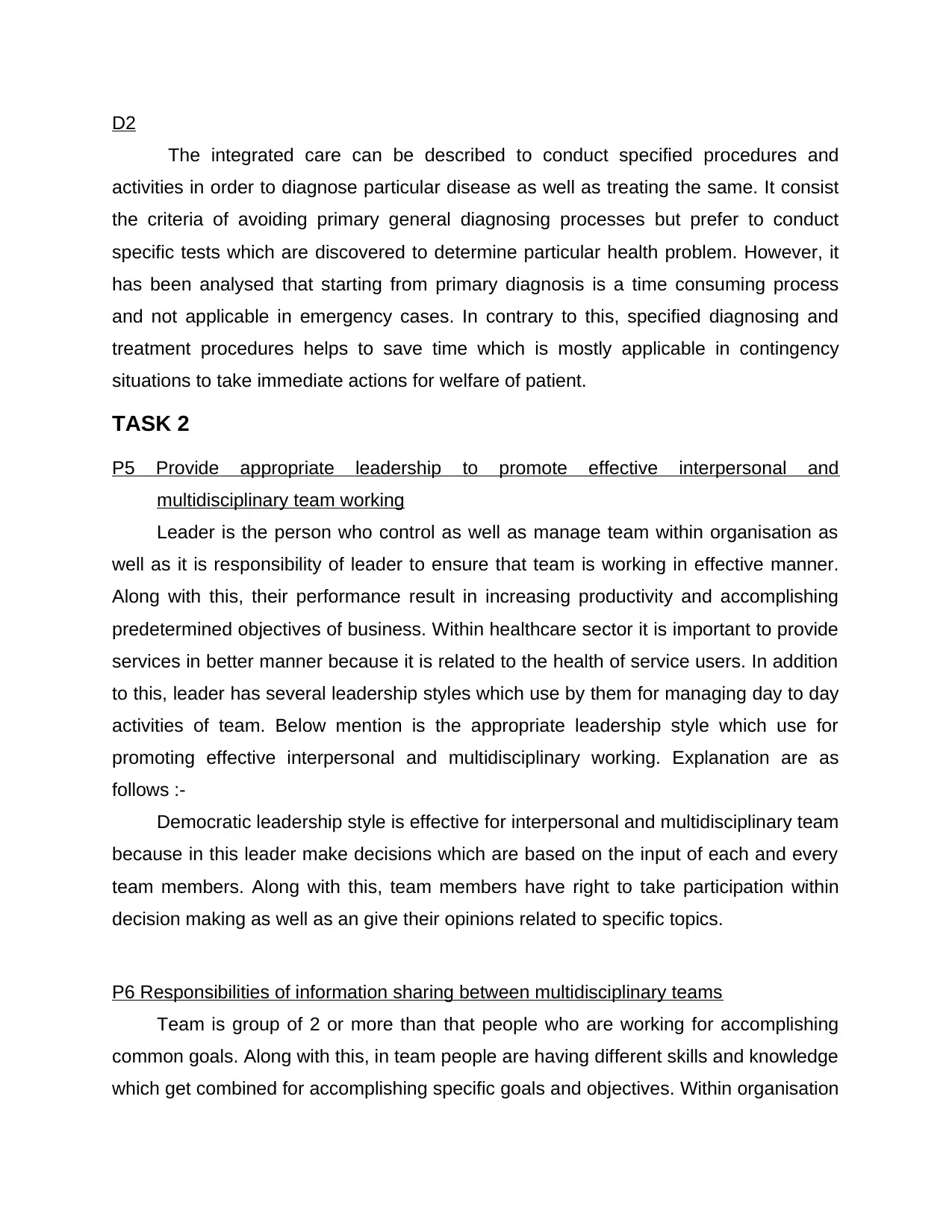
D2
The integrated care can be described to conduct specified procedures and
activities in order to diagnose particular disease as well as treating the same. It consist
the criteria of avoiding primary general diagnosing processes but prefer to conduct
specific tests which are discovered to determine particular health problem. However, it
has been analysed that starting from primary diagnosis is a time consuming process
and not applicable in emergency cases. In contrary to this, specified diagnosing and
treatment procedures helps to save time which is mostly applicable in contingency
situations to take immediate actions for welfare of patient.
TASK 2
P5 Provide appropriate leadership to promote effective interpersonal and
multidisciplinary team working
Leader is the person who control as well as manage team within organisation as
well as it is responsibility of leader to ensure that team is working in effective manner.
Along with this, their performance result in increasing productivity and accomplishing
predetermined objectives of business. Within healthcare sector it is important to provide
services in better manner because it is related to the health of service users. In addition
to this, leader has several leadership styles which use by them for managing day to day
activities of team. Below mention is the appropriate leadership style which use for
promoting effective interpersonal and multidisciplinary working. Explanation are as
follows :-
Democratic leadership style is effective for interpersonal and multidisciplinary team
because in this leader make decisions which are based on the input of each and every
team members. Along with this, team members have right to take participation within
decision making as well as an give their opinions related to specific topics.
P6 Responsibilities of information sharing between multidisciplinary teams
Team is group of 2 or more than that people who are working for accomplishing
common goals. Along with this, in team people are having different skills and knowledge
which get combined for accomplishing specific goals and objectives. Within organisation
The integrated care can be described to conduct specified procedures and
activities in order to diagnose particular disease as well as treating the same. It consist
the criteria of avoiding primary general diagnosing processes but prefer to conduct
specific tests which are discovered to determine particular health problem. However, it
has been analysed that starting from primary diagnosis is a time consuming process
and not applicable in emergency cases. In contrary to this, specified diagnosing and
treatment procedures helps to save time which is mostly applicable in contingency
situations to take immediate actions for welfare of patient.
TASK 2
P5 Provide appropriate leadership to promote effective interpersonal and
multidisciplinary team working
Leader is the person who control as well as manage team within organisation as
well as it is responsibility of leader to ensure that team is working in effective manner.
Along with this, their performance result in increasing productivity and accomplishing
predetermined objectives of business. Within healthcare sector it is important to provide
services in better manner because it is related to the health of service users. In addition
to this, leader has several leadership styles which use by them for managing day to day
activities of team. Below mention is the appropriate leadership style which use for
promoting effective interpersonal and multidisciplinary working. Explanation are as
follows :-
Democratic leadership style is effective for interpersonal and multidisciplinary team
because in this leader make decisions which are based on the input of each and every
team members. Along with this, team members have right to take participation within
decision making as well as an give their opinions related to specific topics.
P6 Responsibilities of information sharing between multidisciplinary teams
Team is group of 2 or more than that people who are working for accomplishing
common goals. Along with this, in team people are having different skills and knowledge
which get combined for accomplishing specific goals and objectives. Within organisation
⊘ This is a preview!⊘
Do you want full access?
Subscribe today to unlock all pages.

Trusted by 1+ million students worldwide
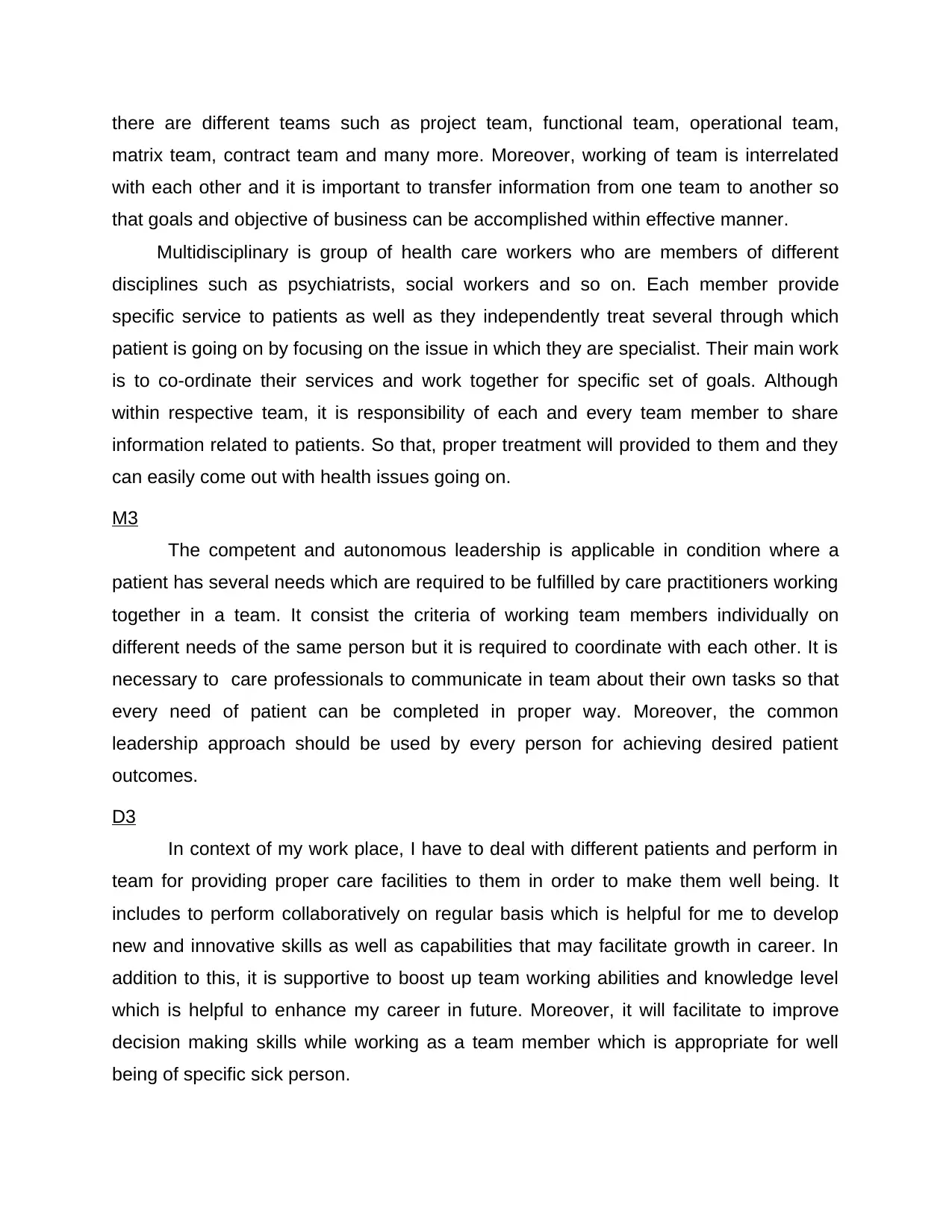
there are different teams such as project team, functional team, operational team,
matrix team, contract team and many more. Moreover, working of team is interrelated
with each other and it is important to transfer information from one team to another so
that goals and objective of business can be accomplished within effective manner.
Multidisciplinary is group of health care workers who are members of different
disciplines such as psychiatrists, social workers and so on. Each member provide
specific service to patients as well as they independently treat several through which
patient is going on by focusing on the issue in which they are specialist. Their main work
is to co-ordinate their services and work together for specific set of goals. Although
within respective team, it is responsibility of each and every team member to share
information related to patients. So that, proper treatment will provided to them and they
can easily come out with health issues going on.
M3
The competent and autonomous leadership is applicable in condition where a
patient has several needs which are required to be fulfilled by care practitioners working
together in a team. It consist the criteria of working team members individually on
different needs of the same person but it is required to coordinate with each other. It is
necessary to care professionals to communicate in team about their own tasks so that
every need of patient can be completed in proper way. Moreover, the common
leadership approach should be used by every person for achieving desired patient
outcomes.
D3
In context of my work place, I have to deal with different patients and perform in
team for providing proper care facilities to them in order to make them well being. It
includes to perform collaboratively on regular basis which is helpful for me to develop
new and innovative skills as well as capabilities that may facilitate growth in career. In
addition to this, it is supportive to boost up team working abilities and knowledge level
which is helpful to enhance my career in future. Moreover, it will facilitate to improve
decision making skills while working as a team member which is appropriate for well
being of specific sick person.
matrix team, contract team and many more. Moreover, working of team is interrelated
with each other and it is important to transfer information from one team to another so
that goals and objective of business can be accomplished within effective manner.
Multidisciplinary is group of health care workers who are members of different
disciplines such as psychiatrists, social workers and so on. Each member provide
specific service to patients as well as they independently treat several through which
patient is going on by focusing on the issue in which they are specialist. Their main work
is to co-ordinate their services and work together for specific set of goals. Although
within respective team, it is responsibility of each and every team member to share
information related to patients. So that, proper treatment will provided to them and they
can easily come out with health issues going on.
M3
The competent and autonomous leadership is applicable in condition where a
patient has several needs which are required to be fulfilled by care practitioners working
together in a team. It consist the criteria of working team members individually on
different needs of the same person but it is required to coordinate with each other. It is
necessary to care professionals to communicate in team about their own tasks so that
every need of patient can be completed in proper way. Moreover, the common
leadership approach should be used by every person for achieving desired patient
outcomes.
D3
In context of my work place, I have to deal with different patients and perform in
team for providing proper care facilities to them in order to make them well being. It
includes to perform collaboratively on regular basis which is helpful for me to develop
new and innovative skills as well as capabilities that may facilitate growth in career. In
addition to this, it is supportive to boost up team working abilities and knowledge level
which is helpful to enhance my career in future. Moreover, it will facilitate to improve
decision making skills while working as a team member which is appropriate for well
being of specific sick person.
Paraphrase This Document
Need a fresh take? Get an instant paraphrase of this document with our AI Paraphraser
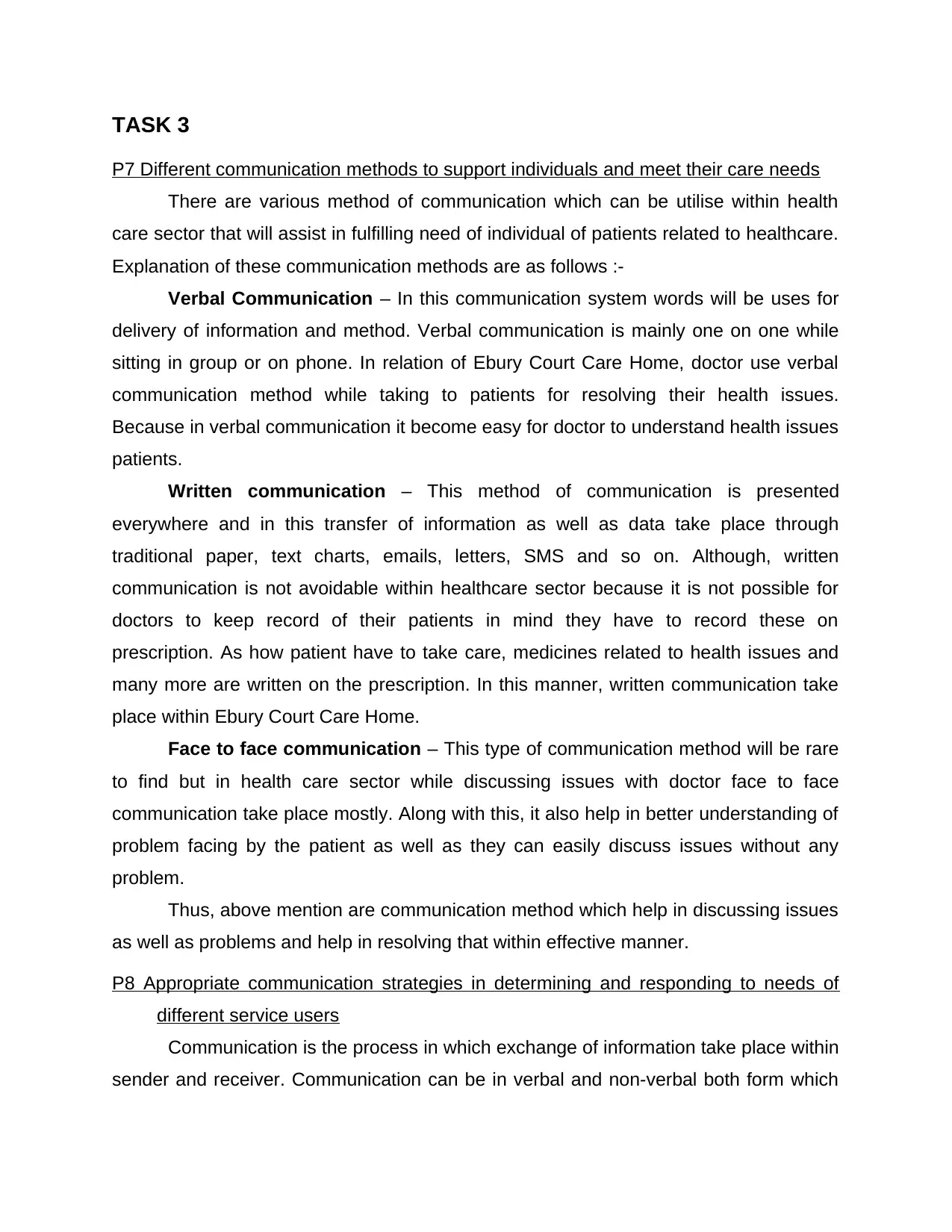
TASK 3
P7 Different communication methods to support individuals and meet their care needs
There are various method of communication which can be utilise within health
care sector that will assist in fulfilling need of individual of patients related to healthcare.
Explanation of these communication methods are as follows :-
Verbal Communication – In this communication system words will be uses for
delivery of information and method. Verbal communication is mainly one on one while
sitting in group or on phone. In relation of Ebury Court Care Home, doctor use verbal
communication method while taking to patients for resolving their health issues.
Because in verbal communication it become easy for doctor to understand health issues
patients.
Written communication – This method of communication is presented
everywhere and in this transfer of information as well as data take place through
traditional paper, text charts, emails, letters, SMS and so on. Although, written
communication is not avoidable within healthcare sector because it is not possible for
doctors to keep record of their patients in mind they have to record these on
prescription. As how patient have to take care, medicines related to health issues and
many more are written on the prescription. In this manner, written communication take
place within Ebury Court Care Home.
Face to face communication – This type of communication method will be rare
to find but in health care sector while discussing issues with doctor face to face
communication take place mostly. Along with this, it also help in better understanding of
problem facing by the patient as well as they can easily discuss issues without any
problem.
Thus, above mention are communication method which help in discussing issues
as well as problems and help in resolving that within effective manner.
P8 Appropriate communication strategies in determining and responding to needs of
different service users
Communication is the process in which exchange of information take place within
sender and receiver. Communication can be in verbal and non-verbal both form which
P7 Different communication methods to support individuals and meet their care needs
There are various method of communication which can be utilise within health
care sector that will assist in fulfilling need of individual of patients related to healthcare.
Explanation of these communication methods are as follows :-
Verbal Communication – In this communication system words will be uses for
delivery of information and method. Verbal communication is mainly one on one while
sitting in group or on phone. In relation of Ebury Court Care Home, doctor use verbal
communication method while taking to patients for resolving their health issues.
Because in verbal communication it become easy for doctor to understand health issues
patients.
Written communication – This method of communication is presented
everywhere and in this transfer of information as well as data take place through
traditional paper, text charts, emails, letters, SMS and so on. Although, written
communication is not avoidable within healthcare sector because it is not possible for
doctors to keep record of their patients in mind they have to record these on
prescription. As how patient have to take care, medicines related to health issues and
many more are written on the prescription. In this manner, written communication take
place within Ebury Court Care Home.
Face to face communication – This type of communication method will be rare
to find but in health care sector while discussing issues with doctor face to face
communication take place mostly. Along with this, it also help in better understanding of
problem facing by the patient as well as they can easily discuss issues without any
problem.
Thus, above mention are communication method which help in discussing issues
as well as problems and help in resolving that within effective manner.
P8 Appropriate communication strategies in determining and responding to needs of
different service users
Communication is the process in which exchange of information take place within
sender and receiver. Communication can be in verbal and non-verbal both form which
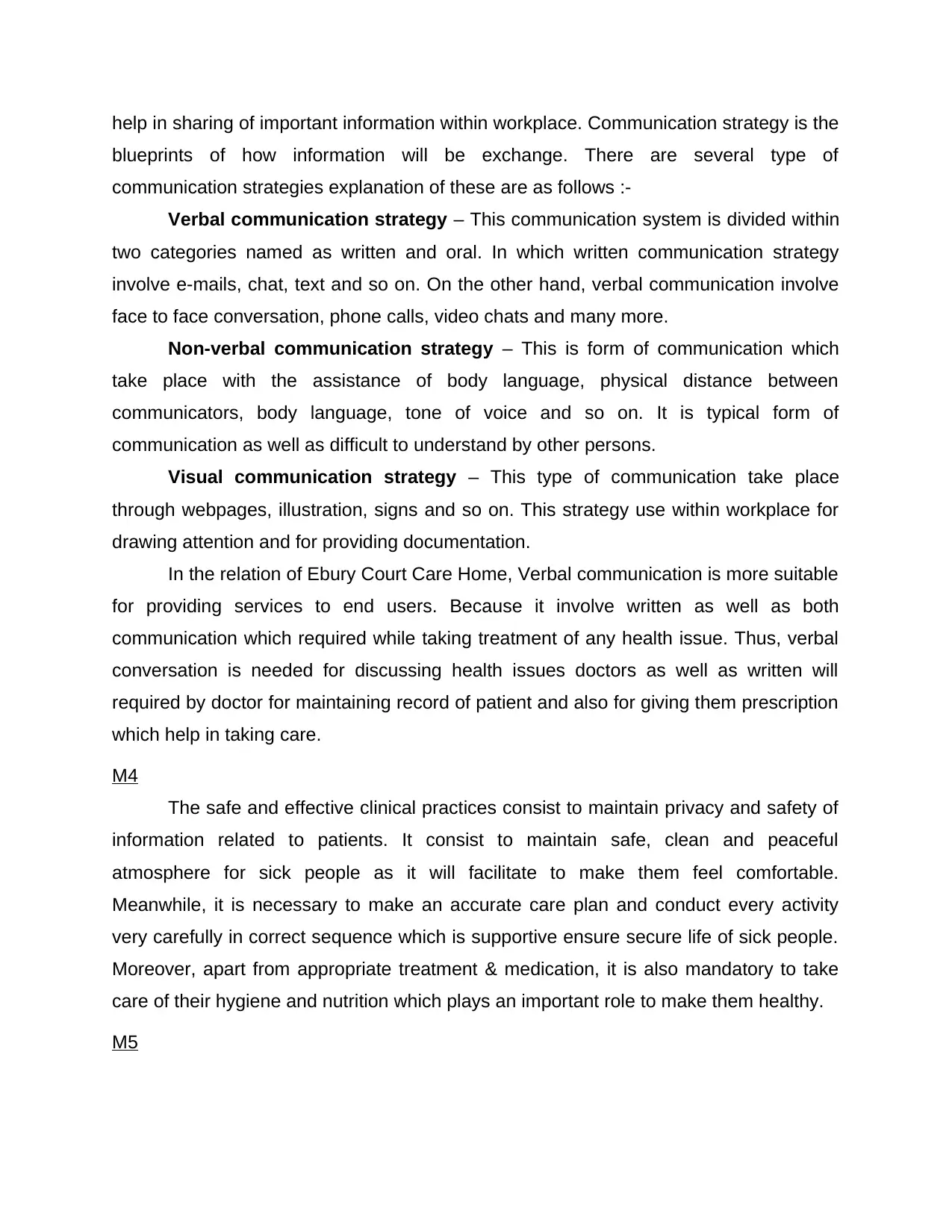
help in sharing of important information within workplace. Communication strategy is the
blueprints of how information will be exchange. There are several type of
communication strategies explanation of these are as follows :-
Verbal communication strategy – This communication system is divided within
two categories named as written and oral. In which written communication strategy
involve e-mails, chat, text and so on. On the other hand, verbal communication involve
face to face conversation, phone calls, video chats and many more.
Non-verbal communication strategy – This is form of communication which
take place with the assistance of body language, physical distance between
communicators, body language, tone of voice and so on. It is typical form of
communication as well as difficult to understand by other persons.
Visual communication strategy – This type of communication take place
through webpages, illustration, signs and so on. This strategy use within workplace for
drawing attention and for providing documentation.
In the relation of Ebury Court Care Home, Verbal communication is more suitable
for providing services to end users. Because it involve written as well as both
communication which required while taking treatment of any health issue. Thus, verbal
conversation is needed for discussing health issues doctors as well as written will
required by doctor for maintaining record of patient and also for giving them prescription
which help in taking care.
M4
The safe and effective clinical practices consist to maintain privacy and safety of
information related to patients. It consist to maintain safe, clean and peaceful
atmosphere for sick people as it will facilitate to make them feel comfortable.
Meanwhile, it is necessary to make an accurate care plan and conduct every activity
very carefully in correct sequence which is supportive ensure secure life of sick people.
Moreover, apart from appropriate treatment & medication, it is also mandatory to take
care of their hygiene and nutrition which plays an important role to make them healthy.
M5
blueprints of how information will be exchange. There are several type of
communication strategies explanation of these are as follows :-
Verbal communication strategy – This communication system is divided within
two categories named as written and oral. In which written communication strategy
involve e-mails, chat, text and so on. On the other hand, verbal communication involve
face to face conversation, phone calls, video chats and many more.
Non-verbal communication strategy – This is form of communication which
take place with the assistance of body language, physical distance between
communicators, body language, tone of voice and so on. It is typical form of
communication as well as difficult to understand by other persons.
Visual communication strategy – This type of communication take place
through webpages, illustration, signs and so on. This strategy use within workplace for
drawing attention and for providing documentation.
In the relation of Ebury Court Care Home, Verbal communication is more suitable
for providing services to end users. Because it involve written as well as both
communication which required while taking treatment of any health issue. Thus, verbal
conversation is needed for discussing health issues doctors as well as written will
required by doctor for maintaining record of patient and also for giving them prescription
which help in taking care.
M4
The safe and effective clinical practices consist to maintain privacy and safety of
information related to patients. It consist to maintain safe, clean and peaceful
atmosphere for sick people as it will facilitate to make them feel comfortable.
Meanwhile, it is necessary to make an accurate care plan and conduct every activity
very carefully in correct sequence which is supportive ensure secure life of sick people.
Moreover, apart from appropriate treatment & medication, it is also mandatory to take
care of their hygiene and nutrition which plays an important role to make them healthy.
M5
⊘ This is a preview!⊘
Do you want full access?
Subscribe today to unlock all pages.

Trusted by 1+ million students worldwide
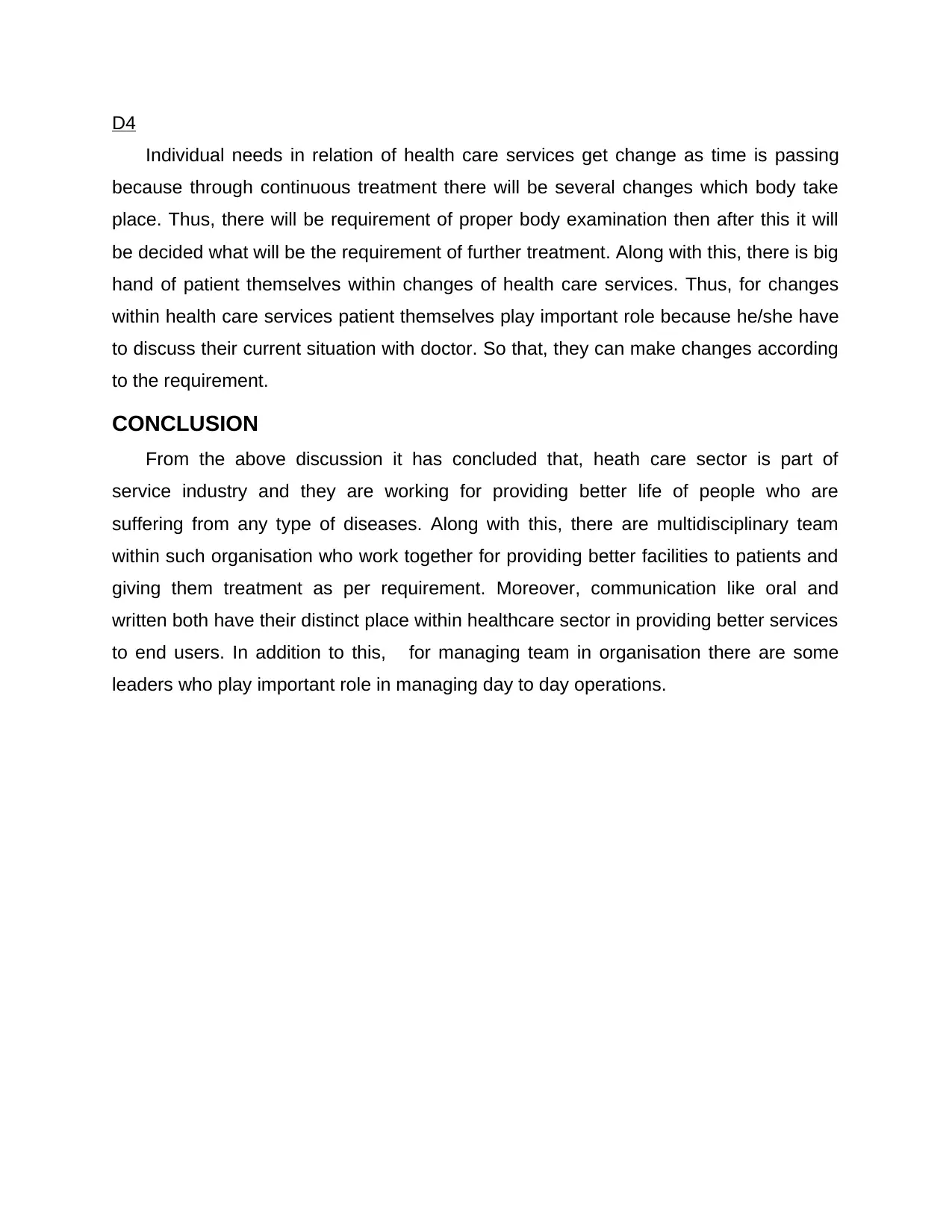
D4
Individual needs in relation of health care services get change as time is passing
because through continuous treatment there will be several changes which body take
place. Thus, there will be requirement of proper body examination then after this it will
be decided what will be the requirement of further treatment. Along with this, there is big
hand of patient themselves within changes of health care services. Thus, for changes
within health care services patient themselves play important role because he/she have
to discuss their current situation with doctor. So that, they can make changes according
to the requirement.
CONCLUSION
From the above discussion it has concluded that, heath care sector is part of
service industry and they are working for providing better life of people who are
suffering from any type of diseases. Along with this, there are multidisciplinary team
within such organisation who work together for providing better facilities to patients and
giving them treatment as per requirement. Moreover, communication like oral and
written both have their distinct place within healthcare sector in providing better services
to end users. In addition to this, for managing team in organisation there are some
leaders who play important role in managing day to day operations.
Individual needs in relation of health care services get change as time is passing
because through continuous treatment there will be several changes which body take
place. Thus, there will be requirement of proper body examination then after this it will
be decided what will be the requirement of further treatment. Along with this, there is big
hand of patient themselves within changes of health care services. Thus, for changes
within health care services patient themselves play important role because he/she have
to discuss their current situation with doctor. So that, they can make changes according
to the requirement.
CONCLUSION
From the above discussion it has concluded that, heath care sector is part of
service industry and they are working for providing better life of people who are
suffering from any type of diseases. Along with this, there are multidisciplinary team
within such organisation who work together for providing better facilities to patients and
giving them treatment as per requirement. Moreover, communication like oral and
written both have their distinct place within healthcare sector in providing better services
to end users. In addition to this, for managing team in organisation there are some
leaders who play important role in managing day to day operations.
Paraphrase This Document
Need a fresh take? Get an instant paraphrase of this document with our AI Paraphraser
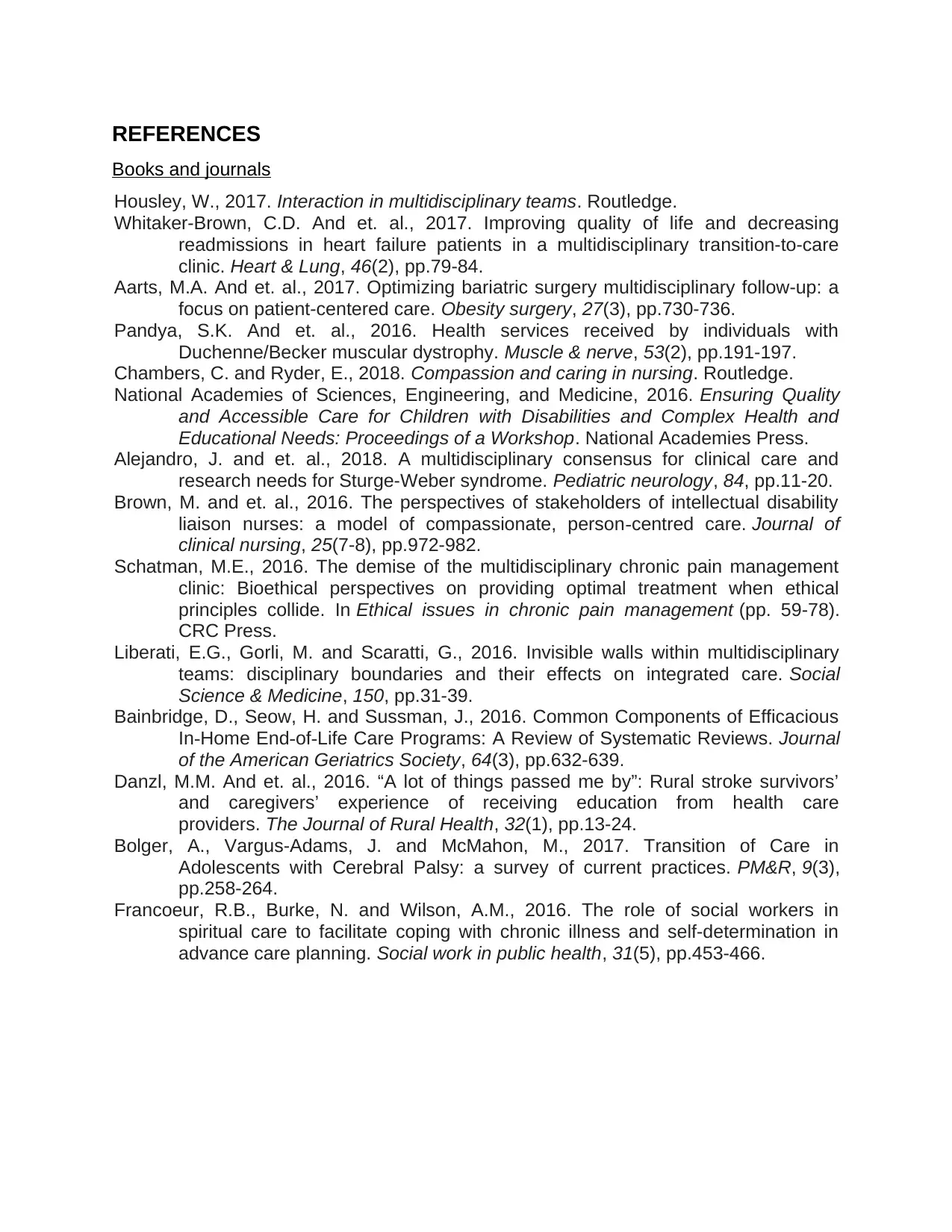
REFERENCES
Books and journals
Housley, W., 2017. Interaction in multidisciplinary teams. Routledge.
Whitaker-Brown, C.D. And et. al., 2017. Improving quality of life and decreasing
readmissions in heart failure patients in a multidisciplinary transition-to-care
clinic. Heart & Lung, 46(2), pp.79-84.
Aarts, M.A. And et. al., 2017. Optimizing bariatric surgery multidisciplinary follow-up: a
focus on patient-centered care. Obesity surgery, 27(3), pp.730-736.
Pandya, S.K. And et. al., 2016. Health services received by individuals with
Duchenne/Becker muscular dystrophy. Muscle & nerve, 53(2), pp.191-197.
Chambers, C. and Ryder, E., 2018. Compassion and caring in nursing. Routledge.
National Academies of Sciences, Engineering, and Medicine, 2016. Ensuring Quality
and Accessible Care for Children with Disabilities and Complex Health and
Educational Needs: Proceedings of a Workshop. National Academies Press.
Alejandro, J. and et. al., 2018. A multidisciplinary consensus for clinical care and
research needs for Sturge-Weber syndrome. Pediatric neurology, 84, pp.11-20.
Brown, M. and et. al., 2016. The perspectives of stakeholders of intellectual disability
liaison nurses: a model of compassionate, person‐centred care. Journal of
clinical nursing, 25(7-8), pp.972-982.
Schatman, M.E., 2016. The demise of the multidisciplinary chronic pain management
clinic: Bioethical perspectives on providing optimal treatment when ethical
principles collide. In Ethical issues in chronic pain management (pp. 59-78).
CRC Press.
Liberati, E.G., Gorli, M. and Scaratti, G., 2016. Invisible walls within multidisciplinary
teams: disciplinary boundaries and their effects on integrated care. Social
Science & Medicine, 150, pp.31-39.
Bainbridge, D., Seow, H. and Sussman, J., 2016. Common Components of Efficacious
In‐Home End‐of‐Life Care Programs: A Review of Systematic Reviews. Journal
of the American Geriatrics Society, 64(3), pp.632-639.
Danzl, M.M. And et. al., 2016. “A lot of things passed me by”: Rural stroke survivors’
and caregivers’ experience of receiving education from health care
providers. The Journal of Rural Health, 32(1), pp.13-24.
Bolger, A., Vargus-Adams, J. and McMahon, M., 2017. Transition of Care in
Adolescents with Cerebral Palsy: a survey of current practices. PM&R, 9(3),
pp.258-264.
Francoeur, R.B., Burke, N. and Wilson, A.M., 2016. The role of social workers in
spiritual care to facilitate coping with chronic illness and self-determination in
advance care planning. Social work in public health, 31(5), pp.453-466.
Books and journals
Housley, W., 2017. Interaction in multidisciplinary teams. Routledge.
Whitaker-Brown, C.D. And et. al., 2017. Improving quality of life and decreasing
readmissions in heart failure patients in a multidisciplinary transition-to-care
clinic. Heart & Lung, 46(2), pp.79-84.
Aarts, M.A. And et. al., 2017. Optimizing bariatric surgery multidisciplinary follow-up: a
focus on patient-centered care. Obesity surgery, 27(3), pp.730-736.
Pandya, S.K. And et. al., 2016. Health services received by individuals with
Duchenne/Becker muscular dystrophy. Muscle & nerve, 53(2), pp.191-197.
Chambers, C. and Ryder, E., 2018. Compassion and caring in nursing. Routledge.
National Academies of Sciences, Engineering, and Medicine, 2016. Ensuring Quality
and Accessible Care for Children with Disabilities and Complex Health and
Educational Needs: Proceedings of a Workshop. National Academies Press.
Alejandro, J. and et. al., 2018. A multidisciplinary consensus for clinical care and
research needs for Sturge-Weber syndrome. Pediatric neurology, 84, pp.11-20.
Brown, M. and et. al., 2016. The perspectives of stakeholders of intellectual disability
liaison nurses: a model of compassionate, person‐centred care. Journal of
clinical nursing, 25(7-8), pp.972-982.
Schatman, M.E., 2016. The demise of the multidisciplinary chronic pain management
clinic: Bioethical perspectives on providing optimal treatment when ethical
principles collide. In Ethical issues in chronic pain management (pp. 59-78).
CRC Press.
Liberati, E.G., Gorli, M. and Scaratti, G., 2016. Invisible walls within multidisciplinary
teams: disciplinary boundaries and their effects on integrated care. Social
Science & Medicine, 150, pp.31-39.
Bainbridge, D., Seow, H. and Sussman, J., 2016. Common Components of Efficacious
In‐Home End‐of‐Life Care Programs: A Review of Systematic Reviews. Journal
of the American Geriatrics Society, 64(3), pp.632-639.
Danzl, M.M. And et. al., 2016. “A lot of things passed me by”: Rural stroke survivors’
and caregivers’ experience of receiving education from health care
providers. The Journal of Rural Health, 32(1), pp.13-24.
Bolger, A., Vargus-Adams, J. and McMahon, M., 2017. Transition of Care in
Adolescents with Cerebral Palsy: a survey of current practices. PM&R, 9(3),
pp.258-264.
Francoeur, R.B., Burke, N. and Wilson, A.M., 2016. The role of social workers in
spiritual care to facilitate coping with chronic illness and self-determination in
advance care planning. Social work in public health, 31(5), pp.453-466.
1 out of 11
Related Documents
Your All-in-One AI-Powered Toolkit for Academic Success.
+13062052269
info@desklib.com
Available 24*7 on WhatsApp / Email
![[object Object]](/_next/static/media/star-bottom.7253800d.svg)
Unlock your academic potential
Copyright © 2020–2025 A2Z Services. All Rights Reserved. Developed and managed by ZUCOL.





